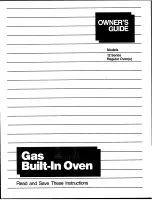
Tested for you in our cooking studio
en
33
Grilling flat items
Flat pieces of poultry, meat and fish, such as steaks,
drumsticks and burgers, can be cooked effectively
using the "Grill" heating function. It is also excellent for
toasting bread.
Grilling
Keep the appliance door closed when using the grill.
Never grill with the appliance door open.
Place the food to be grilled on the wire rack. In addition,
slide the universal pan in at least one shelf position
lower, with the slanted edge facing the appliance door.
Any dripping fat will be caught.
When grilling, try wherever possible to use pieces of
food which are of a similar thickness and weight. This
will allow them to brown evenly and remain succulent
and juicy. Place the food to be grilled directly onto the
wire rack.
Use tongs to turn the pieces of food you are grilling. If
you pierce the meat with a fork, the juices will run out
and it will become dry.
Do not add salt to the meat until it has been grilled. Salt
draws water from the meat.
Notes
■
The grill element switches itself continuously on and
off; this is normal. The grill setting determines how
frequently this occurs.
■
Smoke may be produced when grilling.
Recommended setting values
The table lists values for poultry, meat and fish, with
default values for the weight.
The setting values are based on the assumption that
unstuffed, chilled, ready-to-roast poultry, meat or fish is
placed into a cold cooking compartment.
If you wish to cook heavier poultry, meat or fish, always
use the lower temperature. If cooking more than one
item, use the weight of the heaviest item as a basis for
determining the cooking time. The individual pieces
should be approximately the same size.
As a general rule: The larger the poultry, meat or fish,
the lower the cooking temperature and the longer the
cooking time.
Turn the poultry, meat or fish after approx.
^
to
Z
of
the time listed.
Cover the bottom of the glass cookware with approx. 1/
2 cm of liquid.
The quantity of liquid depends on the type of meat, the
material the cookware is made from and on whether or
not a lid is used. If you are cooking meat in an
enamelled or dark-coloured metal roasting dish, it will
need a little more liquid than if cooked in glass
cookware.
Calculating the cooking time (e.g. 20+35):
To calculate the cooking time, assume 20 minutes per
500 g of meat plus an extra 35 minutes. For 1.5 kg, the
cooking time would therefore be 95 minutes.
Cooking time range (e.g. 10-15):
Your food will be ready within the specified range of
time (in minutes).
Roasting, braising and grilling in the bottom oven
Roasting and Braising
Food
Dish
Shelf posi-
tion
Type of
heating
Tempera-
ture in °C
Time in min-
utes
Beef, slow roast joint
cookware, uncovered
1
7
140 - 150
45 + 40
Beef, top side / top rump
cookware, uncovered
1
:
170 - 180
30 + 25
Lamb, leg (bone-in)
cookware, uncovered
1
:
160 - 170
25 + 25**
Lamb, shoulder (bone-in)
cookware, uncovered
1
:
160 - 170
25 + 20
Lamb, shoulder (boned and rolled)
cookware, uncovered
1
:
170 - 180
25 + 25
Rack of lamb
cookware, uncovered
1
:
170 - 190*
15 + 25**
Pork, roast joint
cookware, uncovered
1
:
180 - 190
30 + 35
Pork, loin joint
cookware, uncovered
1
:
170 - 180
30 + 30
Pork, belly
cookware, uncovered
1
:
170 - 180
30 + 25***
Pork, gammon joint
cookware, uncovered
1
:
160 - 170
30 + 30
Chicken, whole
wire rack
1
:
190 - 200
25 + 15
Chicken, portion (each 200-250g)
cookware, uncovered
1
:
190 - 210
35 - 45
Duck
cookware, uncovered
1
:
180 - 190
25 + 20****
* preheat
** without fat layer (best end neck), do not turn
*** if you want a crispy crust, change to fan + grill 190 for the last 15 min of cooking time
**** turn after app. 1 hour
***** bone side down, do not turn












































